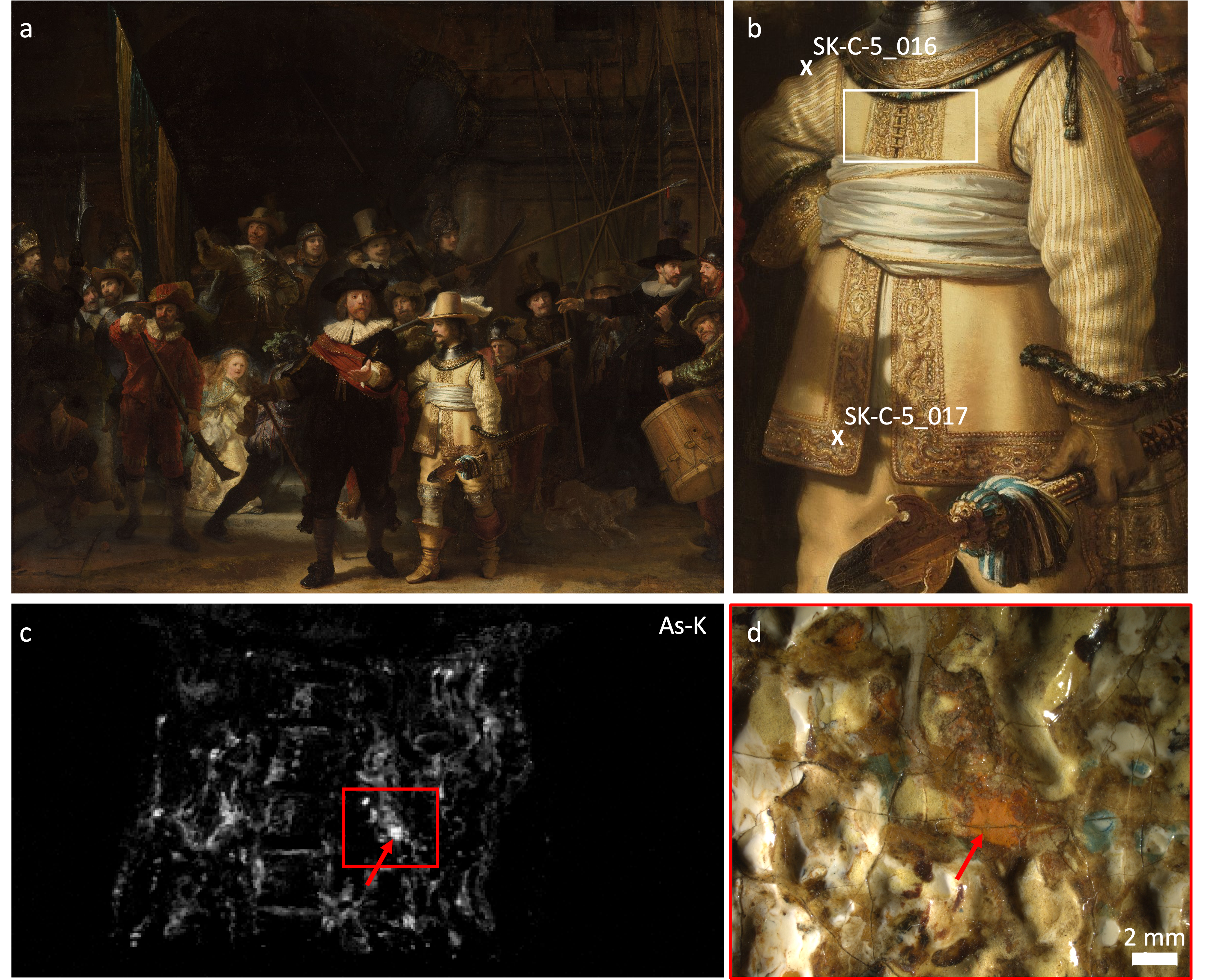Rembrandt, the Dutch Golden Age master, mixed arsenic sulfide pigments in his most famous work, The Night Watch (1642). Research by the Rijksmuseum, which exhibits the painting, and the University of Amsterdam, which has been analyzing it since 2019, maintains that the artist thus created the illusion of a gold thread in the embroidery of Lieutenant Willem van Ruytenburch’s doublet. He is the figure dressed in yellow in the center of the painting, and Rembrandt used materials brought in via European trade routes.
“We thought that Rembrandt had used natural arsenic sulphide pigments, such as orpiment (yellow) and realgar (red) for the gilding effect on Lieutenant van Ruytenburch’s gilt,” explains Fréderique Broers, one of the study’s lead authors, along with Nouchka de Keyser, over the phone. However, the application of high-tech spectroscopy, microscopy and X-ray techniques to two samples obtained in 2019 has revealed the presence of two other components. This was done during the so-called Operation Night Watchand found “to pararrealgar (formed as an alteration of realgar), for yellow, and semi-morphous realgarfor orange/red. The second must have been obtained by heating or roasting the first, obtaining what we call artificial arsenic sulfide,” he says.
Although arsenical pigments were used at the time to paint fruits and flowers in still lifes, this discovery indicates that Rembrandt was innovative in using something else for portraits. Its discovery adds colour to the painter’s palette and broadens the range of materials that 17th-century artists in Amsterdam were thought to be able to obtain.
The research has been published in the journal Heritage Science, And Broers admits that the terminology can be somewhat confusing “because different names are used for each of the pigments over time and in different countries.” However, with the help of specific analytical techniques, “which can distinguish two molecules even if both only contain arsenic and sulphur, we have been able to differentiate them,” he says. The pigments were very toxic in powder form, although once mixed with linseed oil to obtain the paint they were stabilised.
He to pararrealgar It usually appears in old paintings because realgar degrades into this compound over time, according to the expert. However, as it is distributed together with the semi-morphous realgar homogeneously and without alterations in The Night Watch“We believe the painter used them deliberately for the golden reflection effect on the lieutenant’s clothing,” says Broers. He wanted to recreate a luxurious fabric that would capture the light in the composition.
It is not clear whether Rembrandt bought the red and yellow mixture now discovered ready-made, or whether he made it in his workshop. Since the Netherlands has no significant mineral resources, “we believe that they arrived via trade routes in German territory, Vienna and Venice, and the artist could buy them in Amsterdam,” the paper notes. Because of this, the use of natural and artificial arsenic sulfides may have been more common than previously thought in the Golden Age of Dutch painting. The artist did have vermilion, “which is mercury sulfide and also very toxic,” “and earth tones, achieved with iron.” The problem is that they lacked the depth of the mixture with reddish and yellowish tones achieved with arsenic sulfide.
Cocq y Ruytenburch
The Night Watch It is actually titled The military company of Captain Frans Banning Cocq and Lieutenant Willem van Ruytenburch. These are the two main figures in the group of arquebusiers who accompany them on their surveillance mission. The lieutenant “wears a shiny outfit, possibly made of buffalo skin,” according to the Rijksmuseum’s documentation of the work. The sleeveless doublet “is magnificently decorated with dense gold thread embroidery,” and manages to be the centre of attention. Rembrandt was the first to depict figures doing something in a group portrait, and Captain Banning Cocq, dressed in black with a red sash, orders his lieutenant to start the company moving.
The artist and his 17th-century colleagues could consult manuals that explained the possible combinations of materials for painting and how to arrange the different layers. Although they were ignorant of the details of the chemical reactions, “they knew, among other things, that arsenic sulphide should not be mixed directly with lead because it darkened the final effect.” The study includes a review of historical sources to trace the use of the pigments found, and notes something similar in a still life by Willem Kalf, a contemporary of Rembrandt and also resident in Amsterdam. This work belongs to the collection of the Rijksmuseum.
Since 2019, the Operation Night Watch The Rijksmuseum has uncovered some of the secrets of the famous painting. Rembrandt painted feathers on the helmet of one of the figures in the background, which were later erased. The position of the leg of one of the subjects has also been changed; the final number of spears has been reduced; and an initial sketch of the final work, made on the canvas itself, has also been found. It was also possible to see that the upper left part of the canvas – which measures a total of 3.79 x 4.53 metres – was deformed due to the time it spent hanging in another room during the Rijksmuseum’s restoration, carried out between 2003 and 2012. And lead was found in a layer of impregnation spread under the one used as a background to prepare the canvas. Lead creates tiny protuberances that can come loose and damage the whole.
All of this will serve to document and prepare for the conservation and cleaning of the painting, which owes its popular name to the yellowish varnish of the past. “For some time, it was believed that this type of coating added an authentic aspect to a Rembrandt masterpiece,” says Fréderique Broers. After the summer, the museum plans to report on the future of the painting. Operation Night Watch.

